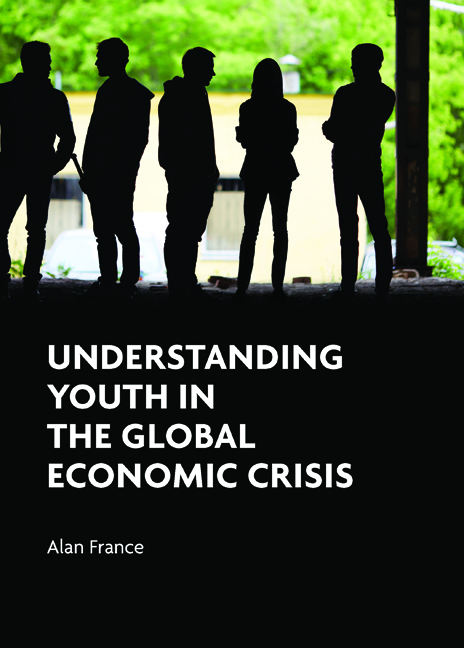Book contents
- Frontmatter
- Dedication
- Contents
- List of tables and figures
- About the author
- Acknowledgements
- Introduction
- One A political ecology of youth
- Two The global crisis and the ‘age of austerity’
- Three Education and training: the broken promise
- Four Education and training: from public good to private responsibility
- Five Unemployment and work: precarious futures
- Six NEETs and the disengaged: the ‘new’ youth problem
- Seven Divergence and difference: contrasting cross-national experiences of being young
- Eight Education, work and welfare in diverse settings
- Nine Youth and mobility: inequality, leaving home and the question of youth migration
- Ten After the crisis: social change and what it means to be young
- References
- Index
Six - NEETs and the disengaged: the ‘new’ youth problem
Published online by Cambridge University Press: 01 September 2022
- Frontmatter
- Dedication
- Contents
- List of tables and figures
- About the author
- Acknowledgements
- Introduction
- One A political ecology of youth
- Two The global crisis and the ‘age of austerity’
- Three Education and training: the broken promise
- Four Education and training: from public good to private responsibility
- Five Unemployment and work: precarious futures
- Six NEETs and the disengaged: the ‘new’ youth problem
- Seven Divergence and difference: contrasting cross-national experiences of being young
- Eight Education, work and welfare in diverse settings
- Nine Youth and mobility: inequality, leaving home and the question of youth migration
- Ten After the crisis: social change and what it means to be young
- References
- Index
Summary
Introduction
In the previous three chapters we concentrated on the changing trends in young people's experience of education and work. In this chapter we turn our attention to those who are seen to ‘slip through the net’ and end up as NEETs (those not in employment, education or training). The concept of NEETs has its origins in the UK (Furlong, 2006). Initially, work by Istance et al in 1994 used the term ‘Status Zero’ to refer to a group of young people in Wales aged 16 to 18 who were not covered by the categories of employment, education or training. In 1999, in New Labour's social exclusion report, this term was reconfigured as the NEET category (Furlong, 2006). Since then it has become a core category in the UK and has gained substantial international currency. As we shall in the discussion that follows, other nation states have accepted it as a central way of measuring the ‘youth problem’. Simultaneously, it has become a core indicator used by the Organisation for Economic Co-operation and Development (OECD), the World Bank, the European Union (EU) and the International Labour Organization (ILO) to measure national success. For example, it has now become a key statistical indicator for youth unemployment and the social situation of youth for the EU's 2020 growth strategy (Eurofound, 2012) and is also a key indicator for comparing the performance of nation states (OECD, 2014a). However, there are substantial problems with its definition (Furlong, 2006; MacDonald, 2013) and how it is used, especially in relation to targeting the ‘workless’.
Connected to the emergence of NEETs is the growing use of active labour market policies (ALMPs) that have been used to tackle the problems of engagement by NEETs. ALMPs are defined as ‘a wide-ranging set of measures designed to “actively” intervene in the labour market in order to improve its functioning’ (Sunley et al, 2006, p.6). They are the opposite of passive policies, or policies such as people receiving unemployment benefits without any obligation, although the distinction between active and passive is blurred in that no benefit system has ever been entirely unconditional (Sunley et al, 2006).
- Type
- Chapter
- Information
- Understanding Youth in the Global Economic Crisis , pp. 135 - 164Publisher: Bristol University PressPrint publication year: 2016

